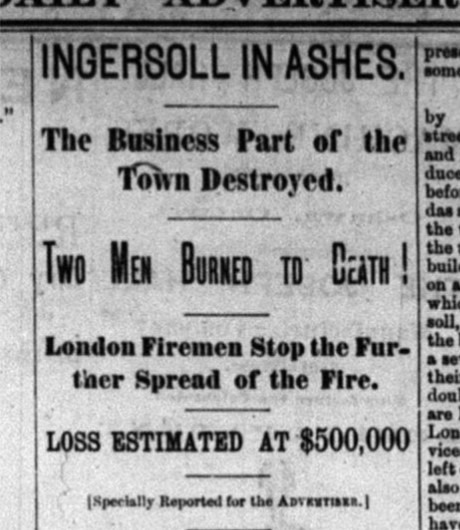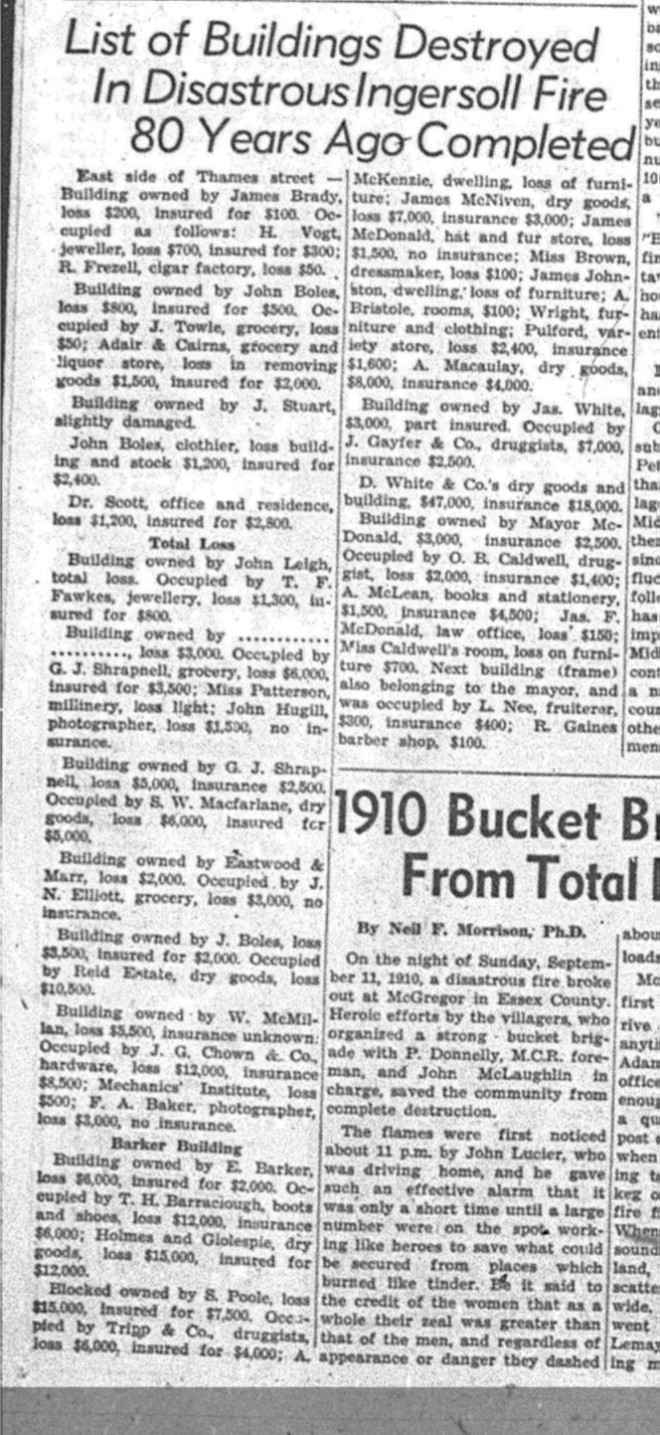The Great Ingersoll Fire of 1872
The Great Ingersoll Fire of 1872
This week, we examine the destructive fire that swept through downtown Ingersoll in 1872.
By Liz Dommasch, Archivist
According to the Woodstock Sentinel-Review “the most terrible and destructive conflagration which has taken place in the western part of Ontario for years” occurred in Ingersoll on May 7, 1872. On that fateful day around 8 o’clock, a fire was discovered in a barn in the rear of the Royal Exchange Hotel (which was unoccupied at the time) at the corner of Thames and Charles Streets. As the entire neighbourhood was occupied by frame buildings the fire spread with “almost lightning rapidity” to the brick block in front and from there crossed the street to the principal business row on Thames Street. It also spread quickly up Oxford Street and burned all in its path until it reached the market square. Luckily residents in this area, along with those on the north side of Charles Street, were able to contain the fire from spreading any further.
western part of Ontario for years” occurred in Ingersoll on May 7, 1872. On that fateful day around 8 o’clock, a fire was discovered in a barn in the rear of the Royal Exchange Hotel (which was unoccupied at the time) at the corner of Thames and Charles Streets. As the entire neighbourhood was occupied by frame buildings the fire spread with “almost lightning rapidity” to the brick block in front and from there crossed the street to the principal business row on Thames Street. It also spread quickly up Oxford Street and burned all in its path until it reached the market square. Luckily residents in this area, along with those on the north side of Charles Street, were able to contain the fire from spreading any further.
As the speed and severity of the fire was too much for the local firemen and the limited means at their disposal, Mayor John McDonald telegraphed both London and Woodstock for assistance. However, by the time both groups arrived the main block was already in ruins. As a result of the blaze, there were some 80 dwellings and businesses in ruins and the monetary lost was estimated at $250,000, of which there was an undetermined amount not covered by insurance. Sadly, two men perished in the flames. Mr. C.C. Paine, pump maker, was killed endeavoring to save goods from R.H. Young’s Saddle Shop, while Mr. John Olmand, of Brantford, lost his life when a wall in Fawkes Jewellery store fell on him while trying to save some of the goods.
On May 15th, Oxford County Council held a special session to consider the propriety of granting aid to assist the inhabitants of the town of Ingersoll to rebuild that portion of their town destroyed by the fire. A lengthy discussion ensued with the proposed notion of issuing debentures to an amount not exceeding fifty thousand dollars. These debentures would be called “Ingersoll Building Fund” which would be under the management of a committee to be named by council. However, according to the council minute, there was opposition manifested by the council and the application for assistance was ultimately withdrawn.
However, this did not impede the town from immediately rebuilding most of the properties destroyed by the fire, which included a number of dry good stores, drug stores, and grocers, as well as D. White & Co. (considered the finest store in town) and the Ingersoll Chronicle. It also led to the introduction of a system of waterworks and fire protection appliances and, according to the 1881 Oxford Gazetteer, actually helped improve the general appearance of the town.
Local poet James McIntyre (see earlier blog post for more information on the “Cheese Poet”) commemorated the event with the following verses:
‘Twas on a pleasant eve in May,
Just as the sun shed its last ray,
The bell it rang, citizens to warn,
For lo! A fire appears in barn.
An ancient barn near hotel stood,
The joining buildings all were wood,
This barn a relic of the past,
There farmers' horses were made fast.
Our once fair town is now in woe,
And we have had our Chicago*,
But soon a nobler town will rise,
For our town is all enterprise.
*Note: The Great Chicago Fire was an inferno that burned in the city of Chicago during October 8–10, 1871. The fire killed approximately 300 people, destroyed roughly 3.3 square miles of the city, and left more than 100,000 residents homeless.
Image credits:
London Advertiser – 8 May 1872. Courtesy of The Ivey Family London Room, London Public Library.
London Free Press – 13 September 1952. Courtesy of The Ivey Family London Room, London Public Library.
Poem credit:
James McIntyre’s Poem Great Fire in Ingersoll, May, 1972
